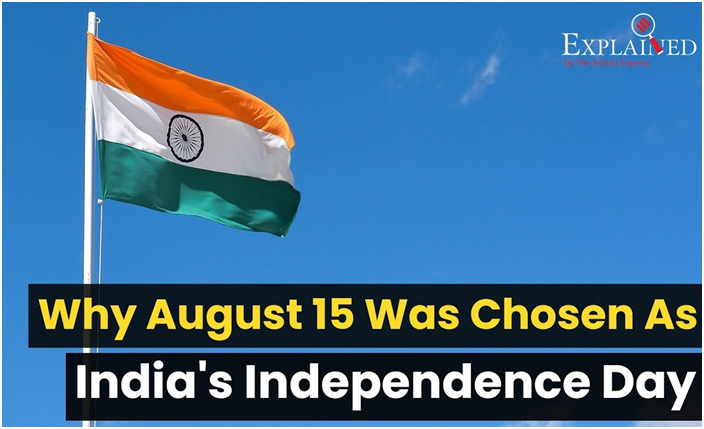Why was 15 August chosen as India’s Independence Day? (GS Paper 1, Modern India)

Context:
- India will be celebrating its 76th Independence day on Monday, August 15, 2022.
- From 26 January 1929 to 15 August 1947 to 30 June 1948, India has witnessed many changes before its official date of Independence was declared.
- Finally, Lord Mountbatten, the last Viceroy of India, picked 15 August 1947 as the day that would see the end of the colonial rule.
The call for “PoornaSwaraj”:
- In 1929, Jawaharlal Nehru adopted the resolution of ‘PoornaSwaraj’, meaning full independence, at the Lahore session of the Indian National Congress (INC).
- The resolution came into being after the talks between the then Viceroy of India Lord Irwin and Indian delegates; Mohammad Ali Jinnah, Jawaharlal Nehru, Mahatma Gandhi and Tej Bahadur Sapru to grant full independence failed.
- The British offered only dominion status to India but the leaders were not pleased. They demanded complete independence and were not ready to budge.
- The call for PoornaSwaraj was a shift from INC’s erstwhile demand of dominion status. Following this resolution, it was decided that India willobserve its Independence Day on 26 January from 1930s onwards.
- Since then, until 1947, for India 26 January was the day of celebration.
Mandate toLord Mountbatten:
- Following years of struggle and bloodshed that finally forced the British to surrender their rule in India, the British Parliament gave Lord Mountbatten the mandate to transfer the power to India by June 30, 1948.
- The freedom fighters, who gave their all for India’s independence, objected to the delay.
- In order to avoid further bloodshed and riots, Mountbatten decided to bring forward the date of independence to 15 August, 1947.
- The first Governor General C Rajagopalachari said, “If he (Lord Mountbatten) had waited till June 1948, there would have been no power left to transfer.”
The “Dickie Bird” plan:
- On 3 June 1947, Mountbatten devised a plan to speed up the process of granting independence to the country.
- The ‘Mountbatten Plan’, as it was popularly known, came after his ‘Dickie Bird Plan’ under which it was proposed that the country’s provinces should be declared as independent successors states. They would have the power to choose whether to join the constituent assembly or not.
- The ‘Dickie Bird Plan’ was opposed by Jawaharlal Nehru. So, Mountbatten dropped it and came up with a new ‘Mountbatten Plan’.
‘Mountbatten Plan’:
- This plan announced that India will be divided into two nations – India and Pakistan. It gave both the countries autonomy and sovereignty, and also granted them the right to form their own Constitution.
- The ‘Mountbatten Plan’, which was accepted by the INC and the Muslim League, gave Jammu and Kashmir the option to either remain independent or join India or Pakistan.
- The Indian Independence Act of 1947 was based on the provisions of the Mountbatten Act which dislodged the British Monarch from India. The British Parliament could no longer enact any law that would be binding on either India or Pakistan.
- After inputs from Mountbatten, the British House of Commons passed the Indian Independence Bill on 4 July, 1947. It made provisions for the end of the British rule on 15 August 1947.
Why did Mountbatten choose 15 August?
- The reason why Mountbatten picked 15 August was because the day coincided with the second anniversary of Japan’s surrender in World War II.
- According to his own account documented in the book ‘Freedom at Midnight’, Mountbatten said, “The date I chose came out of the blue. I chose it in reply to a question. I was determined to show I was the master of the whole event. When they asked if we had set a date, I knew it had to be soon. I hadn't worked it out exactly then — I thought it had to be about August or September, and I then went out to August 15. Why? Because it was the second anniversary of Japan’s surrender."
- After days of fierce battle between the allied and axis powers, Japan (an axis power) decided to surrender after atomic bombs –destroyed the cities of Hiroshima and Nagasaki.
- On 15 August 1945, Japan’s emperor Hirohito delivered a speech to his nation declaring that the country had given up and will no longer be fighting in the Second World War.
Why India and Pakistan have two different days of Independence?
- Although the Indian Independence Act clearly states that both India and Pakistan were to get independence on 15 August, it is not entirely clear why the latter celebrates its freedom a day before.
- Pakistan chose 14 August as its day of independence as it was the last Friday of the month of Ramazan in 1947, hence making it an auspicious day for Muslims.
- Another theory that explains Pakistan’s decision to advance their Independence Day is that Mountbatten was scheduled to formally transfer powers to Indian and Pakistani leaders on 14 and 15 August in New Delhi and Karachi, respectively.
- But since he couldn’t be at both places at the same time, he decided to go to Karachi on 13 August. It was on this day that he said, “Tomorrow the government of the new Dominion of Pakistan will rest in your hands”.Therefore, the Pakistan government decided to advance its Independence Day by a day.
- However, Mountbatten’s hope to divert another bloodshed by shifting the date of Independence for India was misplaced. The Partition was not a sordid affair. Several lives were lost and many people ended up homeless.


